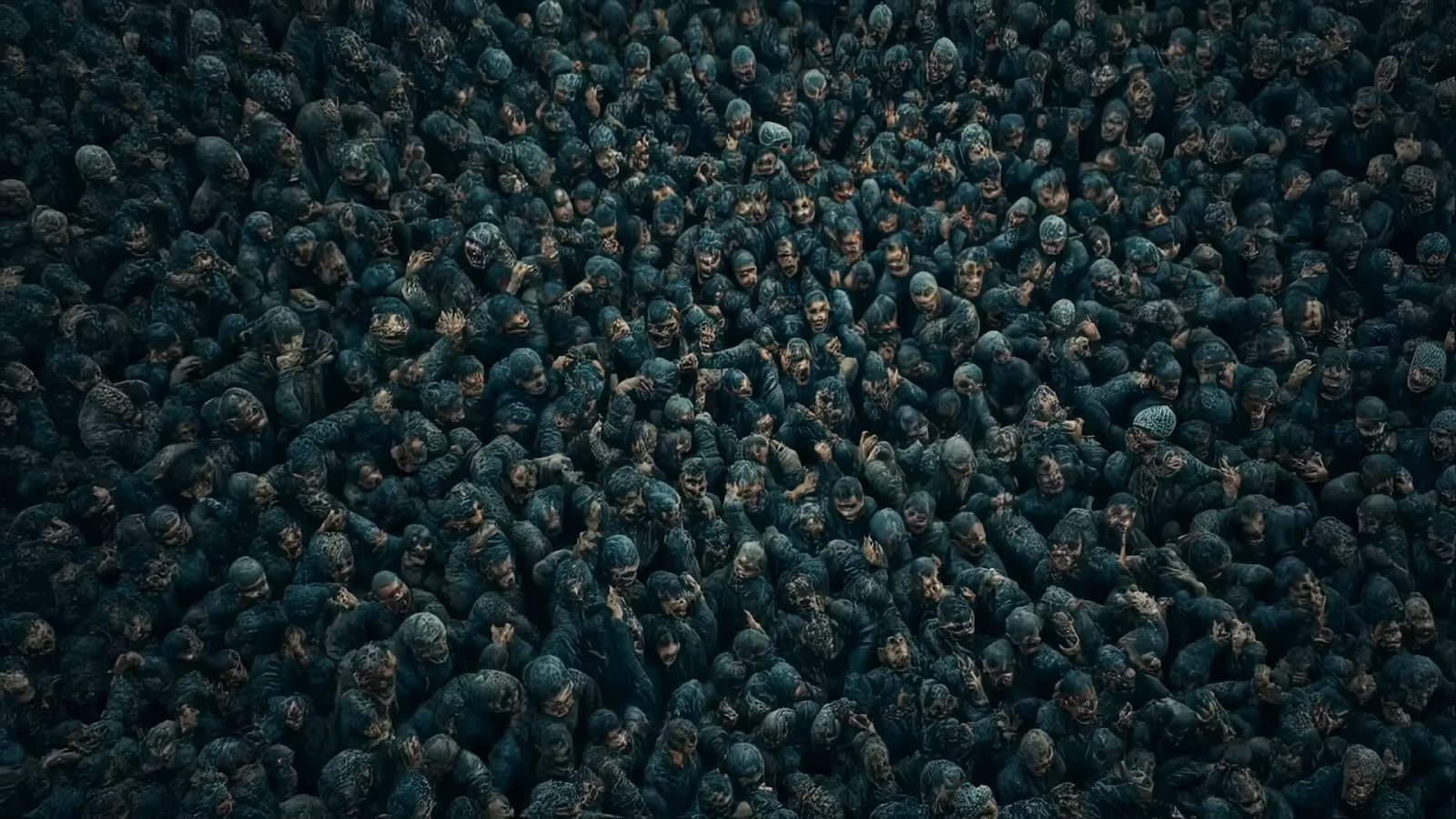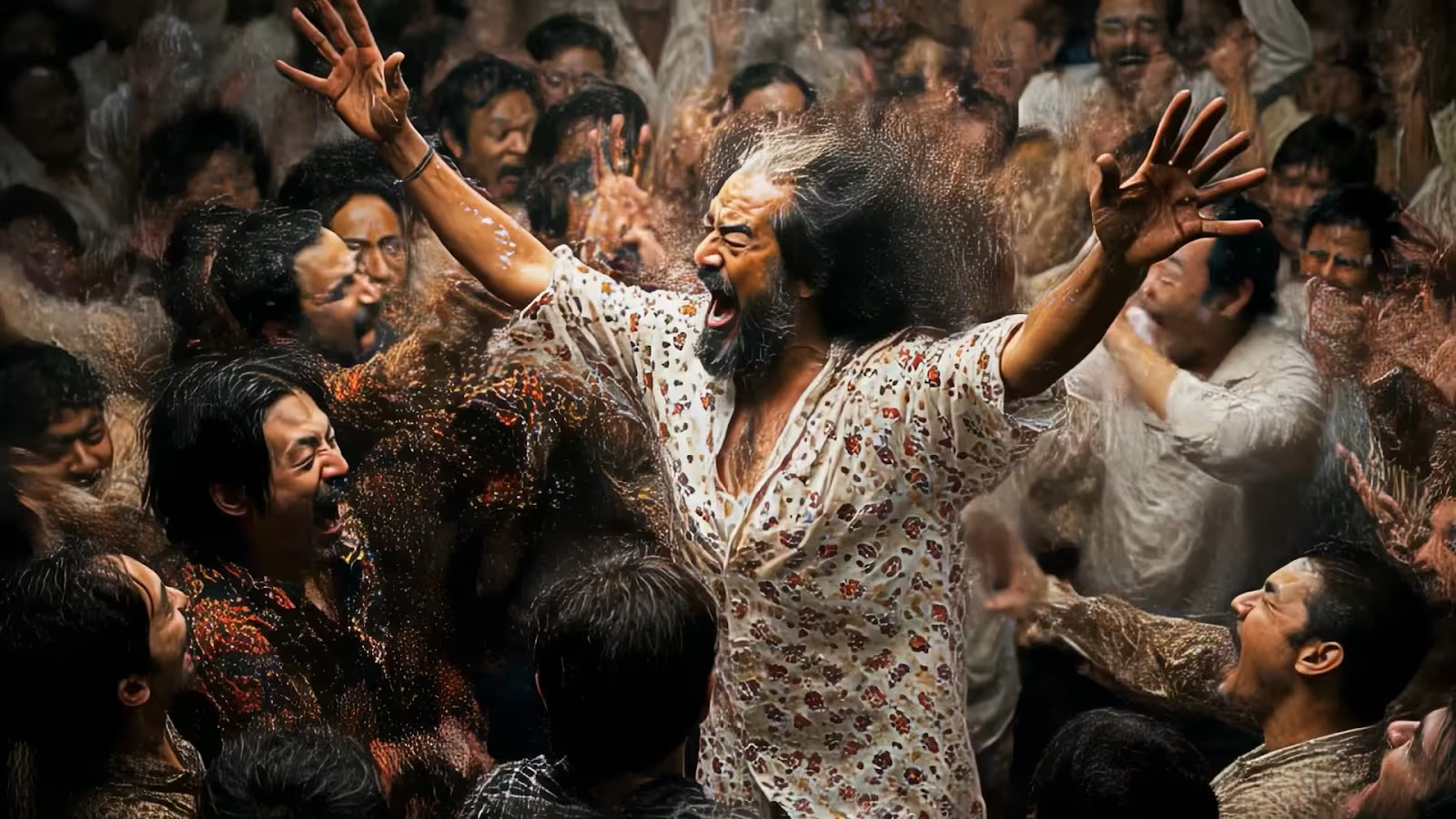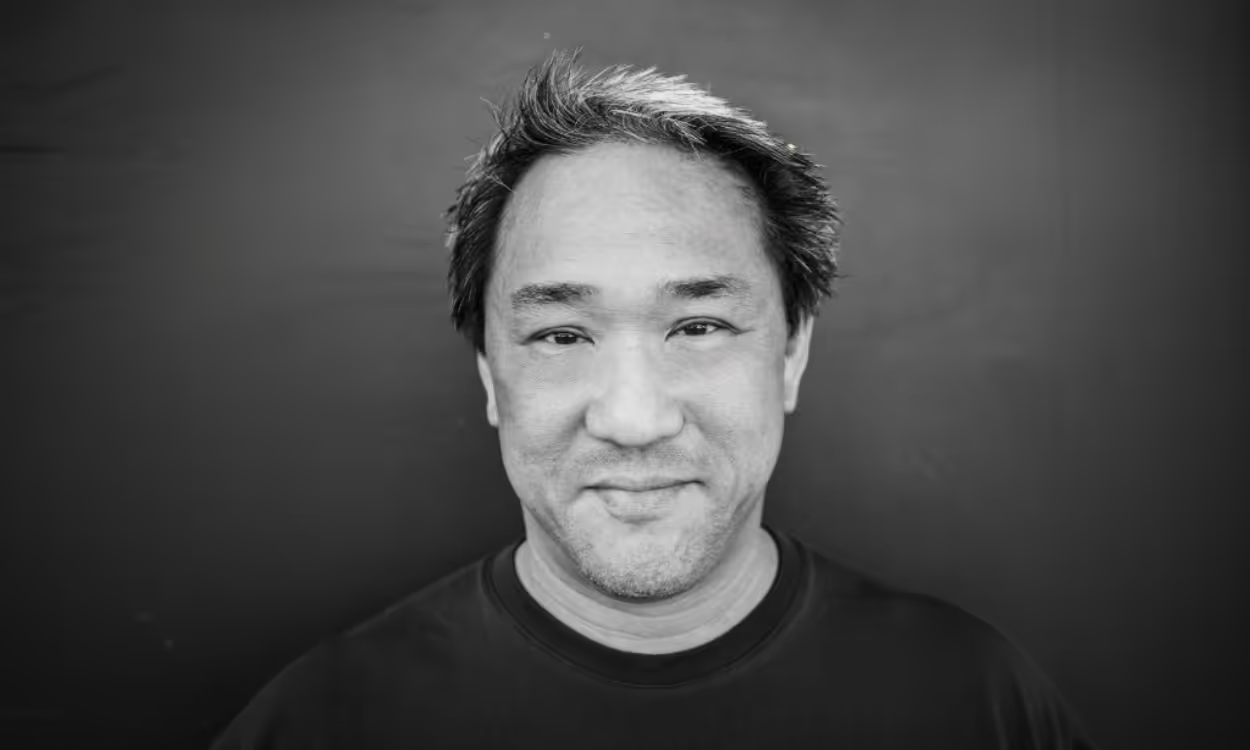Chikai Ohazama isn’t afraid to take the unexpected path. A former tech exec turned gallery founder turned artist, his journey through web3 has been one of curiosity, reinvention, and experimentation. Known for richly layered video works that blend physical and digital, his latest project, Anomalia, continues that exploration.
What sets Anomalia apart isn't just the format, it’s the philosophy. Chikai invites viewers to break from the flow, to move against the grain, and to reflect on what it means to exist in parallel dimensions: physical and digital, individual and collective, surface and depth. In this conversation, we talk about the project’s inspiration, how AI video unlocked something creative he hadn’t accessed before, and why the magic often lies in what you didn’t ask it to do.

OpenSea: You’ve got an upcoming drop with OpenSea. Tell us about the project and the inspiration behind it.
Chikai Ohazama: The drop is called Anomalia. It’s a combination of physical still prints and a digital video collection. The digital part is dropping through OpenSea, and the physical prints just debuted at the Hamptons Fine Art Fair last week, which was very cool — it was great to show the work in-person to a live audience.
It’s a two-part drop. I’ve been really intentional about how I approach the physical and digital components, rather than just doing a simple 1/1 or putting something on a screen. There’s a unique conceptual structure to how I think about both mediums.
Thematically, Anomalia is about breaking away from the flow — whether that’s societal norms, trends, or social groups — and saying, “No, I’m going in a different direction.” It reflects the spirit of independent thinking and seeing the world in a different way, which might be counter to what everyone else is doing. That spirit shows up in different ways throughout the work.

OpenSea: Interesting. Do you feel like this project is in line with your past work, or is it more of a departure?
Chikai Ohazama: It’s definitely an extension. The first series in this artistic style was called Panopticon — I launched it maybe a year and a half ago. It was just 10 pieces, which I created at the end of 2023 and released in 2024. The idea was this zoom-in, zoom-out motif — you’d get both detailed imagery and the broader composition in one piece. That series sold out in a few days, which was amazing.
Near the end of that, I was talking with Justin Trimble at Braindrops about doing a larger release on their platform. That expanded the original concept into a 1-of-500 collection, building on the zoom motif.
There was also a small series called Hominis, which was my first foray into combining physical and digital. That was shown at Alisan Fine Arts in New York at the end of last year. It was another evolution of the same motif. Anomalia extends it again — but this time, when you zoom in on the physical piece, it doesn’t just show more detail. It transports you into a totally different dimension. The larger composition might be a central figure in a crowd, but when you zoom in, you get something completely different — oceanic scenes, fish, aquatic life. It’s a visual metaphor for existing on a totally different plane or in an alternate universe. That contrast, both in an overt and metaphorical way, is really central to the work.

OpenSea: It’s a very cool concept. Your pieces often combine physical and digital elements. How do you see the role of blockchain in that? Is it a necessary split, or are these two sides of one whole? What’s your thinking behind keeping both?
Chikai Ohazama: For me, it came from wanting to be intentional about how my work exists in the physical world. Early on in NFTs, I think a lot of artists had never had their work displayed before. So when a gallery in New York showed their work on a screen, that alone felt like a huge win. There wasn’t much thought about how the work was presented; they were just excited it was being shown.
But over time, I started to feel like the screen alone didn’t do justice to a lot of digital work. Aspect ratios, resolution, even the feeling — it often fell short. So when I started thinking about bringing my own work into physical spaces, I wanted to be deliberate about how it was shown.
I saw a lot of great examples from other artists — lenticular prints by Alpha Centauri Kid, what Sam Spratt did with Monument Game and Masquerade. They made very intentional choices: “This is how I want my work to exist in the world.”
I think Avant Arte has done a great job with that too, through their prints and editions. So for me, it wasn’t about taking a digital image and sticking it on a screen. It was about expressing the same aesthetic and motif across two formats — but in different ways. For this project, the digital is video-based, while the physical is still imagery. You zoom into the video by literally zooming the frame. With the physical work, you walk closer and discover new dimensions. It’s the same core concept, just rendered through different experiences.

OpenSea: I’d love to hear more about your path into web3. Was there a particular moment when it felt like a tipping point, when you realized, “This is really the technology I want to be working in”?
Chikai Ohazama: Yeah, I actually came into it by accident. I never planned to go into art, or crypto, or NFTs. I’d never even bought crypto. I remember seeing things like Nyan Cat selling for half a million dollars and thinking, “What is going on here?” It didn’t seem rational.
So I started digging into it, mostly from the art side. I was always more interested in that than in the PFP world. And as I explored, I realized I really liked the art being made. I started collecting. And that act of collecting turned out to be surprisingly social. When you bought something, people would notice. They’d celebrate with the artist, with the collector — it was incredibly welcoming. I’d never experienced anything like that before.
I came in just out of curiosity and started collecting. Over time, that led to starting my own gallery called Monolith Gallery, which did quite well, especially with photography, during that early NFT period. But then AI started to emerge, and I found myself asking again: “What is this? What am I looking at?”
If I was going to collect AI art, I felt like I needed to understand it. So I started experimenting with Midjourney and other tools, just trying to grasp the medium. I looked back at GANs and what had been done historically. Braindrops did a great job of putting that history on-chain.
At some point, I started making my own work — not because I set out to become an artist, and honestly, I didn’t even think I could. But I showed something to ACK and he said, “This is good.” That gave me the confidence to keep going.
Then in summer 2023, AI video really took off. I dove in fully. I couldn’t stop creating. And look, I think there are definitely times where collectors try to make that jump and the community rejects them — like, “What is this guy doing?” or “Is he just trying to make a buck?” But in my case, the community actually embraced me as an artist, and that meant everything.
I never expected that to become my identity — that “artist” would be the thing that defines me now. But it’s where I’ve landed. I had some creative background — I’ve written music, directed plays — but that’s not how I entered the space.

OpenSea: So interesting. I was going to ask about that identity shift, but it sounds like you’ve always had a drive to create and put something original into the world. This just became a new outlet for that.
Chikai Ohazama: Yeah. I didn’t necessarily think of myself that way until I looked back and realized — yeah, whether it’s music or product design or plays, it’s all part of that same creative thread. AI video just gave me a medium to express that in a way I hadn’t found before. But I think it really came out because AI video gave me a way to express myself as an artist in a way no other technology ever had. I’ve tried creative tools before, but nothing hit like AI video. And the second part — which honestly surprised me — was that the community accepted it.
I totally expected some people to reject me — like, “Who is this guy?” There are plenty of collectors who try to make the jump and get dismissed. But somehow, people embraced what I was doing. And I’ve been really grateful for that.
OpenSea: AI as a medium is constantly evolving. The tools are everywhere, but having access doesn’t mean everyone can create something meaningful. So how did you land on AI as your medium?
Chikai Ohazama: You know, I think it kind of chose me. AI images were interesting, but they didn’t really resonate — I didn’t feel like I could add anything with them. But when AI video took off, that’s when it clicked. It tapped into something much deeper for me.
And I think a lot about people who are incredibly creative but don’t have the time or circumstances to explore that. Life gets in the way — kids, jobs, maybe you studied something else. Maybe you wanted to be an artist, but you became a doctor or engineer instead. There are folks like Grant Yun, who’s a doctor and still creating art.
OpenSea: Yeah, we’ve talked about that — it’s so interesting.
Chikai Ohazama: Right? I think for many people, life just doesn’t give you the space to explore your creative side. But AI — especially AI video — gives people the chance to do that. You don’t need a big budget or a full crew to make a film. You can take what’s in your head and make it real.
That was the moment for me. The technology gave me a window: “Okay, now you can do this.” And I’ve seen that happen for others too. It unlocks something creative in people who’ve never had a way to express it before.
OpenSea: You’ve said before that the “magic” of AI is often in what it does that you didn’t ask it to do. Can you give an example of that — something that emerged in the process and ended up becoming central to the work?
Chikai Ohazama: Actually, Anomalia is a perfect example of that. Some people write these super detailed prompts. They use elaborate frameworks, visual programming tools — they build a whole architecture to get a very specific result.
I do almost the opposite. I’ll start with something really simple — like “woman” or “woman at a desk.” That’s it. By keeping it vague, I let the AI dream. It hallucinates. And once I see a direction I like, then I start refining. I’ll dig deeper into that path.
It’s very much an exploratory process. I might have a vague idea of the feeling I want — the emotion behind it — and then I run hundreds, sometimes thousands of generations to find a few that resonate. So it’s not about having a specific image in mind. It’s about chasing a feeling — and letting the AI help me find it. How do I get that feeling into the piece?
It could be specific — like a life event or something I’m reacting to — but it usually starts from a feeling.
OpenSea: Yeah. I think that’s a powerful way AI works. It gives you a lot to narrow down and sparks creativity along the way. It’s constantly showing you alternate paths as you move through your own.
Chikai Ohazama: Yeah, and some tools are better at it than others. Some are really good at generating exactly what you ask for. But others are better at hallucinating. Which isn’t great for legal or medical advice, but it’s amazing for art.
OpenSea: You’ve talked about transitioning from collector to creator. How do you see your role as creator and collector evolving?
Chikai Ohazama: Good question. I haven’t thought about that in a while. Monolith has mostly become a place to hold and celebrate my collection. A place to show what I’ve bought and why. There’s so much focus in this space on the next drop, the next mint. But there’s less reflection on what we’ve already collected. So Monolith has kind of evolved into that for me.
Whether it’ll sell things again? I don’t know. That depends on timing, opportunity, the market. There are other ways to explore that. But I’m still very active as a collector.
The only reason I’m not more active is because you really have to be on it—on the ball for drops, when things close, etc. I just don’t have time to place the right bid at the right moment. I miss a lot of stuff. And now you're also competing with funds, which have way more resources than I want to deploy at any one time.
But I still love it. I genuinely do. Some people love thrifting — finding the perfect jacket for $5. That was never me. But with art, I love the hunt. Finding something no one else saw, a gem before anyone else noticed. That thrill hasn’t gone away.
Now I feel like my collecting is splitting into two tracks: there’s the hunt, but also the support. NFTs aren’t just art anymore — they’re communities, projects, experiments. And there are people and things I want to see succeed. Like Roger Dickerman’s 24 Hours of Art. I want that to exist. I don’t want it to disappear.
OpenSea: Is there anything else about your upcoming drop that you want our readers to know?
Chikai Ohazama: That's a good question. The structure of this release is very different from what you'd typically expect with a physical and digital drop. Even the way it's released.
Usually, you get an NFT with each individual physical piece. This one is different. There are 15 still-image pieces as physical prints. But there’s no one-for-one full-res version of those in the digital world. Instead, there’s a 1-of-500 digital edition — built from around 60 unique source images — that generates those 500 pieces. They're thematically linked, but not one-to-one matches. So I hope the audience understands that, and maybe even embraces it. It’s definitely a different kind of release, and hopefully people enjoy it.
OpenSea: Thank you so much for this insight. It was such a pleasure getting to chat with you and hear about your process.
Chikai Ohazama: Thank you.





.avif)
.png)

.png)
.png)



.png)